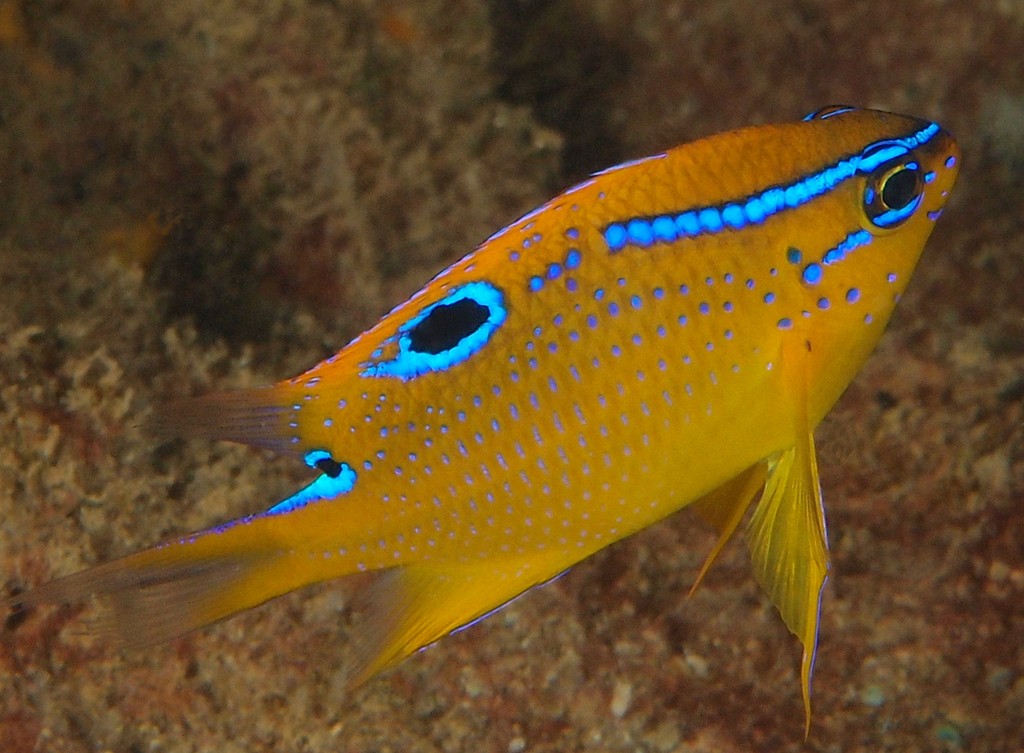NEOGLYPHIDODON POLYACANTHUS - (OGILBY, 1889)
Actinopterygii (Gigaclass) > Actinopteri (Class) > Teleostei (Subclass) > Blenniiformes (Order) > Pomacentridae (Family) > Pomacentrinae (Subfamily) > Neoglyphidodon (Genus)
Demoiselle à queue jaune, Multi-spined damsel, Multispine damsel, Multispine damselfish, Yellowtail demoiselle, 多棘新箭齿雀鲷,
Demoiselle à queue jaune, Multi-spined damsel, Multispine damsel, Multispine damselfish, Yellowtail demoiselle, 多棘新箭齿雀鲷,
Synonymes
Glyphidodon polyacanthus (Ogilby, 1889)
Paraglyphidodon polyacanthus (Ogilby, 1889)
Glyphidodon polyacanthus (Ogilby, 1889)
Paraglyphidodon polyacanthus (Ogilby, 1889)
----------------------------
Description
Dorsal spines (total): 14; Dorsal soft rays (total): 13-14 (usually: 14); Anal spines: 2; Anal soft rays: 13-14; Pectoral fin rays: 18; Lateral line scales: 18-19; Gill rakers: 22-23; Body depth: 1.9-2.1 in SL. Margins of preopercle and suborbital smooth. Suborbital scaleless, teeth biserial. Max. length: 15.0 cm TL. Depth range: 2 - 30 m.
Color
Juveniles yellow-orange with a narrow blue band from snout to and surronding a black sport below middle of dorsal fin.
Adults brown with darker scale margins.
Etymology
Neoglyphidodon: from Greek, para = the side of + from Greek, glyphis = carved + from Greek, odous = teeth.
polyacanthus: from Ancient Greek, polús = many, much + from ancient Greek, ákanthos = thorn, spine. Referring to 14 dorsal-fin spines, exceeding the maximum (13) Ogilby knew about among its presumed congeners in Glyphisodon (=Abudefduf).
Description
Dorsal spines (total): 14; Dorsal soft rays (total): 13-14 (usually: 14); Anal spines: 2; Anal soft rays: 13-14; Pectoral fin rays: 18; Lateral line scales: 18-19; Gill rakers: 22-23; Body depth: 1.9-2.1 in SL. Margins of preopercle and suborbital smooth. Suborbital scaleless, teeth biserial. Max. length: 15.0 cm TL. Depth range: 2 - 30 m.
Color
Juveniles yellow-orange with a narrow blue band from snout to and surronding a black sport below middle of dorsal fin.
Adults brown with darker scale margins.
Etymology
Neoglyphidodon: from Greek, para = the side of + from Greek, glyphis = carved + from Greek, odous = teeth.
polyacanthus: from Ancient Greek, polús = many, much + from ancient Greek, ákanthos = thorn, spine. Referring to 14 dorsal-fin spines, exceeding the maximum (13) Ogilby knew about among its presumed congeners in Glyphisodon (=Abudefduf).
Original description: Glyphidodon polyacanthus Ogilby, 1889 - Type locality: Lord Howe Island (Australia) located in the Tasman Sea between Australia and New Zealand.
Distribution
Southwestern Pacific: Capricorn Group (southern Great Barrier Reef, Queensland, Australia), Lord Howe Island and Norfolk Island (Australia), New Caledonia.
Biology
Adults occur outside the lagoon, usually in deeper surge channels on the leeward side of reefs in the Capricorn Group, Queensland, Australia. Ubiquitous at Lord Howe Island. Oviparous, distinct pairing during breeding. Eggs are demersal and adhere to the substrate. Males guard and aerate the eggs.
Similar species
Chrysiptera brownriggii (Bennett, 1828) - Reported from Indian Ocean: South Africa, East Africa, Socotra, Seychelles, Comoros, Madagascar and Mascarenes east to western Indonesia.
Distribution
Southwestern Pacific: Capricorn Group (southern Great Barrier Reef, Queensland, Australia), Lord Howe Island and Norfolk Island (Australia), New Caledonia.
Biology
Adults occur outside the lagoon, usually in deeper surge channels on the leeward side of reefs in the Capricorn Group, Queensland, Australia. Ubiquitous at Lord Howe Island. Oviparous, distinct pairing during breeding. Eggs are demersal and adhere to the substrate. Males guard and aerate the eggs.
Similar species
Chrysiptera brownriggii (Bennett, 1828) - Reported from Indian Ocean: South Africa, East Africa, Socotra, Seychelles, Comoros, Madagascar and Mascarenes east to western Indonesia.
Chrysiptera leucopoma (Cuvier, 1830) - Reported from New Caledonia.
Mecaenichthys immaculatus (Ogilby, 1885) - Reported from Southwestern Pacific: New South Wales (Australia) endemic. Juveniles are similar.
Neoglyphidodon mitratus (Allen & Erdmann, 2012) - Reported from Western Pacific: Palau; Papua New Guinea; Solomon Islands. Juveniles are similar.
Parma mccullochi (Whitley, 1929) - Reported from Southeastern Indian Ocean: Kalbarri to Recherche Archipelago (Western Australia endemic). Juveniles are similar.
Parma microlepis (Günther, 1862) - Reported from Southeastern Indian Ocean, southwestern Pacific: New South Wales, Victoria and Tasmania (southeastern Australia); New Zealand. Juveniles are similar.
Parma oligolepis (Whitley, 1929) - Reported from Southwestern Pacific: Cape Tribulation (Queensland) south to Sydney (New South Wales, Australia). Juveniles are similar.
Parma unifasciata (Steindachner, 1867) - Reported from Southwestern Pacific: Noosa Head (Queensland) to Montague Islands (New South Wales, Australia). Juveniles are similar.
Parma mccullochi (Whitley, 1929) - Reported from Southeastern Indian Ocean: Kalbarri to Recherche Archipelago (Western Australia endemic). Juveniles are similar.
Parma microlepis (Günther, 1862) - Reported from Southeastern Indian Ocean, southwestern Pacific: New South Wales, Victoria and Tasmania (southeastern Australia); New Zealand. Juveniles are similar.
Parma oligolepis (Whitley, 1929) - Reported from Southwestern Pacific: Cape Tribulation (Queensland) south to Sydney (New South Wales, Australia). Juveniles are similar.
Parma unifasciata (Steindachner, 1867) - Reported from Southwestern Pacific: Noosa Head (Queensland) to Montague Islands (New South Wales, Australia). Juveniles are similar.
Last update: 30, August 2022
